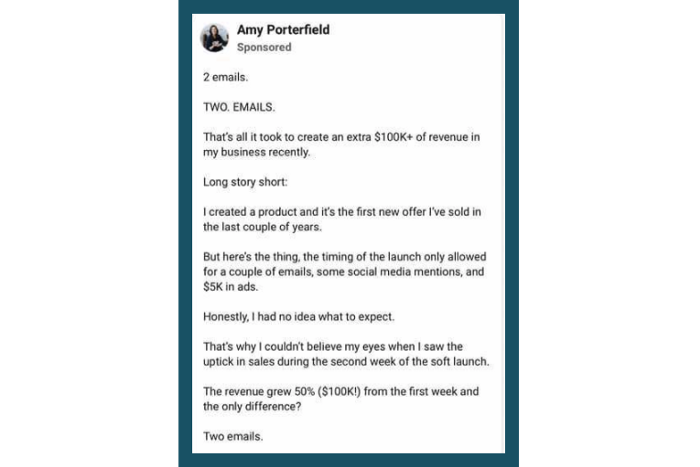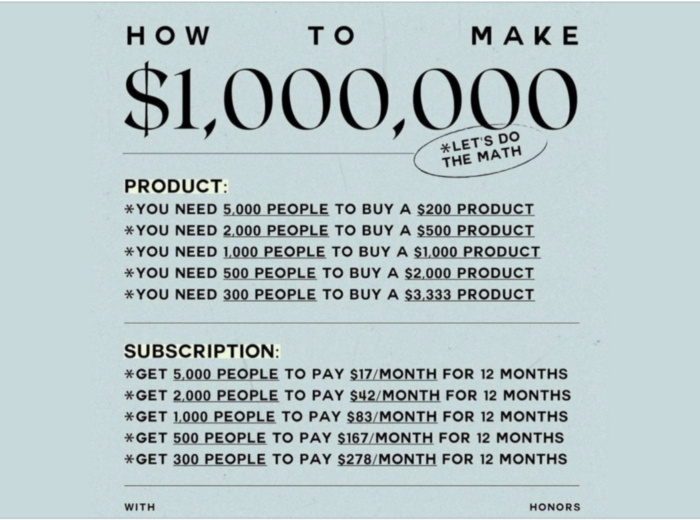Did you hear? Everyone was cancelling Amy Porterfield last month.
Amy Porterfield is an online marketing expert with a popular podcast and a substantial audience. She’s been in the business of online business for years. Prior to doing her own thing, she directed content for Tony Robbins.
Amy’s team is running ads all the time. (Here are all of her active ads for reference.) One recent ad ruffled a lot of feathers.
Here it is:

People flipped. “This is unrealistic and represents everything that’s wrong with the online business world!” bemoaned one canceller.
4 Lucrative Online Business Models That Require < 750 Email Subscribers - Post Outline
The funny thing about the cancel campaign is that the screenshot being circulated was only part of the ad.
Here is the full ad:

In a nutshell, the backlash was that making large sums of money from just two emails sends a bad message and sets impossible expectations for entrepreneurs.
But as the full ad notes, building an engaged audience to Amy’s size requires years of consistency, strategy, and punching above your weight when it comes to content creation.
This leads us to an important truth about the world of online entrepreneurship:
Most People Have A Tiny Audience Or No Audience At All
That was the case for me for years. I quietly ran a consulting business and flourished in profitable anonymity.
Popularity is not a prerequisite for success in online business.
And so the usual business models touted in online business and the creator economy — paid newsletters, membership models, evergreen webinar launches, and so on — require a substantial audience. Amy’s been doing this for 12 years; stop comparing yourself to Amy Porterfield.
You don’t need a big audience to make bank. But if your audience is small, and you want to make decent money online or have it be your full-time gig, your business model might need a second look.
Specifically, you need a model that will allow you to charge more money to fewer customers.
Here is an image I found recently and bookmarked. 7-figure fever is overrated, but this graphic does do a nice job of reframing the different ways you can make it online:

So if you have a small audience — which I would classify as under 750 email subscribers — consider exploring one or more of the following business model formats.
Related: Substack Review: Why You Should (or Shouldn't) Start an Email List
Model #1: Freelancing/Ghostwriting (Project focus)
You can make great money with no audience by pitching and landing freelancing projects. I specifically named ghostwriting here because I know a lot of you are writers.
The way you land a project is with a proposal, and y’all can put that on my tombstone when I die. When I say “project”, I’m referring to pitching something that will have a clear start and a clear finish, and when I say “proposal” I’m referring to strategies like these.
“I’ll write for you!” is not a project.
“I will interview you, then write four 1,000-word articles for you over a 45-day period and be available for Q&A along the way via email with a response time of one business day” is a project.
Here’s the bad news for all of the business models we’re discussing today…You have to go fishing in order to find leads, have conversations, and close clients. 🎣
Manual prospecting is a powerful way to get conversations going. It’s been the engine of business for, oh, I don’t know, centuries?
And yet, most people simply aren’t willing to do it. Methinks we’ve gotten worse at it over the years as more indirect forms of communication like social media have become more dominant.
People want an online business that frees them from the shackles of their 9-to-5 job, but then
- They don’t want to grow an audience
- They don’t want to create content
- They don’t want to reach out to other business owners or people in their network
- They don’t want to sell
- They don’t want to deal with rejection
And so on.
But they definitely want to work 4 hours a week from a laptop in Bali. Remember that article from a few months ago? That article went completely viral and was a fluff piece at best.
Let me ask you something
Have you tried?
- Have you manually prospected 250 business owners?
- Have you competed 100+ sales calls?
- Have you made a concerted effort to befriend one new online entrepreneur in your network every day?
- Have you invested an hour or more each week into learning the landscape of online business so that you’re more likely to succeed?
Oh… you haven’t?
Forgive the snark, but that’s probably why you’re not getting results.
I’m not romanticizing hustle porn when I ask those questions. I’m genuinely asking whether you have prioritized doing the uncomfortable, unsavory actions that actually move the needle in business.
Most people don’t.
They’re focusing instead on other tasks instead that do not lead to high-dollar clients.
You’re posting on TikTok and then setting up a Substack and then hosting rooms on Clubhouse and then futzing with your Instagram bio AGAIN because you will do absolutely anything to avoid the uncomfortable, client-generating tasks that are quietly terrifying.
Prospecting takes practice, and you get rejected a lot at first. It’s important to stay the course.
You can do this.
Most people give up quickly in online business. By persisting, you will eventually make it to the front by default.
Model #2: Freelancing/Ghostwriting (Retainer focus)
I know, I know, this is technically very similar to the model we just discussed.
Here is the difference: Instead of a standalone project with a clear beginning and end, you’re pitching to help someone on a month-to-month basis specifically with implementation.
- Would your continued support from month to month help your clients build momentum or achieve their goals?
- Do your clients need things done for them each month that they cannot do themselves — or that hiring an employee would be too expensive for?
- Can you clearly illustrate how keeping you around directly translates into making or saving money, having more harmonious health or relationships, or improving peace of mind?
If the answer to any of those questions is yes, you should consider a retainer-driven business model.
Businesses love to hire contractors and consultants. I love hiring contractors and consultants. Pitch me, please. Why hire a full-time employee and bloat payroll when I can just hire someone highly skilled for 8 or 10 hours a week instead?
Contractors are almost always an option for business owners, and that’s good news for you.
Pro tip: Offer pay-in-full incentives
Consider offering a discount in exchange for paying for 3 months, six months, or even a whole year of service upfront.
This goes back to the “time value” of money. The time value of money states that money in your pocket now is more valuable than money in your pocket later. When you have a lump sum of money now, you can turn around and invest it into more marketing, fancier software, better administrative support, or joining a program to help you sharpen your skills.
Money in your pocket now is more valuable because you can use it to grow your business.
Not everyone likes to write a big check on day one. But some people have the cash on-hand to do so.
Offer both options.
“The time value of money states that money in your pocket now is more valuable than money in your pocket later.”
Model #3: Consulting Packages
In this model and the next, you are being paid for your knowledge, insight, and recommendations. What you’re not doing in this format is getting your hands dirty.
You’re not providing implementation or done-for-you service; instead, you’re guiding your clients on what to do and helping them take action on those insights more quickly.
The word “consulting” often has a corporate charge to it. I like to think of consulting more as strategy, tactics, and recommendations, whereas coaching looks more into personal behaviors or priorities that are showing up in someone’s business and/or life.
If you’ve taken the time to learn different software tools and strategies over the years — and have a knack for diagnosing problems and then offering clear, customized solutions or recommendations — then this approach might be a great fit for you.
How I did it for a long time
For years in my business, I offered this package style on the front end and project proposals on the backend.
How I would offer this consulting is through something called a roadmap session: A strategy deep-dive that includes a call recap and then some project options for next steps.
I learned this approach from Brennan Dunn, whose audience includes a lot of web developers who pitch large buildouts.
The advantage to taking this roadmap session approach before pitching larger projects
is that you have a better sense of what work there actually is to do and how you can be most helpful. In a roadmap session, both parties have already signed a nondisclosure agreement, so you can get into the numbers and talk about what’s really happening.
Do some consulting, then put together a roadmap. Then offer your clients options to keep working with you and bring the roadmap to life.
This one-two punch is often how people break through and land their first or next five-figure proposal and beyond.
Model #4: Coaching Packages
If you know you can help clients get results through a 1-on-1 coaching package, then you don’t need an audience of 50,000 followers to have a full client book.
All you need are… clients.
As mentioned above, coaching differs from consulting in that it centers more on someone’s behavior. When you coach, you’re focused on providing support and empowerment, whereas in consulting you’re more focused on providing strategy and direction.
These are not hard and fast rules, but I find that distinguishing the two can help you shape your value proposition.
Ask yourself these two questions
- Where do people tend to hit snags?
- Why are your clients not following through on the things they already know how to do and are supposed to be doing to grow their business?
In online business, we often reach a point where we don’t need more information; we need more accountability, support, and outside feedback to grow.
And for God’s sake, raise your prices
Too many of you are hitting a wall with this approach because you’re not charging enough. You’re needing 20, 30, or 40 clients at a time to make those $250/month 1-on-1 packages work, which is going to burn you out real quick.
Charge your happy price. This is the price in which you energetically shift from the feeling of “I don’t wanna do this” to a feeling of “This is worth my time and energy”.
I bet for a lot of you your happy price is higher than what you’re charging at the moment. Time to hike those prices ⬆️, ⏫, and 🆙.
Be happy. Happy prices help you get there. ☺️
Final Thoughts
Two emails won’t make you a fortune overnight unless you’ve done the work to build a large, engaged audience. But that doesn’t mean you’re doomed to have a tiny business forever.
Prioritize getting in front of the right people with the right offers and your small-but-mighty readership will be more than enough to flourish as an entrepreneur.
Thanks for reading. 🙏🏼
Keep up the momentum with one or more of these next steps:
📣 Share this post with your network or a friend. Sharing helps spread the word, and posts are formatted to be both easy to read and easy to curate – you'll look savvy and informed.
📲 Hang out with me on another platform. I'm active on Medium, Instagram, and LinkedIn – if you're on any of those, say hello.
📬 Sign up for my free email list. This is where my best, most exclusive and most valuable content gets published. Use any of the signup boxes in this article, or go to the newsletter page here.
🏕 Up your marketing game: Camp Wordsmith™ is my business and writing program for small business owners and online entrepreneurs. Get instant access to resources and templates guaranteed to make your marketing hustle faster, better, easier, and more fun. (It's also "glamping"-themed – who doesn't love luxurious camping?!) Learn more here.
📊 Hire my marketing company: Hefty Media Group provides consultation and done-for-you services in content marketing. We're a certified diversity supplier with the National Gay & Lesbian Chamber of Commerce, and we'll make you sound damn good via the written word. Learn more here.
© 2021, 2022, Hefty Media Group. All Rights Reserved.


